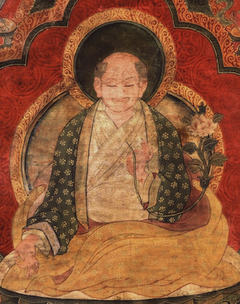Parting from the Four Attachments
Instruction on Parting from the Four Attachments
by Nubpa Rigdzin Drak
Homage to the guru!
The great and holy Lama Sakyapa said that anyone longing to seek the supreme great bliss of nirvāṇa must part from the four attachments. These four attachments are:
- attachment to this life;
- attachment to the three realms of saṃsāra;
- attachment to your own self-interest;
- attachment to a true reality or existence in things and their characteristics.
Their antidotes are four:
- as an antidote to the first attachment, meditation on death and impermanence
- as an antidote to the second, reflecting on the faults of saṃsāra;
- as an antidote to the third, reflecting on bodhicitta, the heart of the awakened mind;
- as an antidote to the fourth, reflecting that all phenomena are devoid of self, like a dream and a magical illusion.
As you reflect in this manner and gain some degree of familiarity, four results will accrue:
- your practice becomes genuine Dharma;
- Dharma progresses along the path;
- the path will clarify confusion;
- as the result of having developed understanding and familiarity, confusion will arise as primordial wisdom and you attain perfect buddhahood.
First, the reflection on death and impermanence which is the remedy for attachment to this life: to think about the uncertainty of the hour of death; to contemplate the profusion of factors which can lead to death; and to reflect at length on how nothing but the Dharma is of any help or use at death. When you have really cultivated this kind of contemplation, a desire will arise, from your heart, to do nothing except practise Dharma. This is when ‘practice becomes genuine Dharma’.
Next, there is the reflection on the faults of samsara, which counteracts attachment to the three realms of saṃsāra. Although you can see how our lives now are fraught with imperfections, you might still wonder: “What about others, like the emperor of the world or the gods Brahmā and Indra, don’t they experience supreme and total bliss?” No, they do not. They too are not beyond suffering, which is the very nature of things. Though they may live for many aeons, and revel in all their wealth, pleasure and enjoyment, in the end they too must face death and it will all be destroyed. Thereafter they risk being born in the hell of ultimate torment. So reflect and think about how beings do not evade, any of them, the nature of suffering, and as you become really familiar with this, ‘Dharma progresses along the path’.
Recognizing that the three realms are not beyond the nature of suffering, you will develop an attitude where you say to yourself, “I must have the happiness which comes from passing beyond sorrow, the happiness of nirvāṇa.” With this aim in mind, you will practise the various paths.
Then, even if you have developed this renunciation in your minds, since you do not possess the bodhicitta, the ‘heart of the awakened mind’, striving purely for your own happiness can only lead to your becoming an arhat or a pratyekabuddha. So, as an antidote to this fixation on your own self-interest, there is the reflection on bodhicitta.
Think along these lines: “To free myself alone from the suffering inherent in the three realms will not be of any use or benefit. Take these sentient beings, each and every one: there is not a single one who has not been my very own father or mother. So as long as they can attain the supreme bliss of nirvāṇa, even if I have to be born as a hell-being, aeon after aeon, that’s fine with me!” Developing and getting familiar with such an attitude will dispel the first kind of delusion on the path, that of attachment to your own self-interest.
Now even though you train in such a way, as long as there remains any grasping towards true existence, you will never attain omniscience. So to counteract fixation on a real existence to things and their characteristics, you need to bring to mind the selflessness of all phenomena. The sheer nature of all phenomena is that they have no intrinsic existence. Grasping at them as being truly existent is ‘the view of self’, whereas fixating on their emptiness is ‘the view of nihilism’. So you should look at all phenomena as being like a dream. Think: “When I switch dream and appearances and I meditate on this, then appearances become unreal. Yet, while they are unreal, still they appear.” If you reflect and meditate on this again and again, you will remove the second type of confusion on the path, that of clinging to things and their characteristics as truly existent or real.
When all confusion has been dispelled and finished, this is known as ‘confusion dawning as wisdom’. At this point, you have attained the result, and there arises in you the supreme bliss of perfect buddhahood, along with the kāyas, wisdoms and other qualities to defy the imagination.
This instruction on ‘Parting from the Four Attachments’ was spoken by the lord of yogis, Drakpa Gyaltsen.
| Rigpa Translations, 2011.
Bibliography
Tibetan Edition
nub pa rig 'dzin grags. "nub pa rig 'dzin grags kyis mdzad pa'i zhen pa bzhi bral" in 'jam mgon kong sprul blo gros mtha' yas, bkra shis dpal 'byor (ed.). gdams ngag mdzod/. 18 vols. Paro: Lama Ngodrup and Sherab Drimey, 1979–1981 (BDRC W20877). Vol. 6: 315–317
Version: 1.4-20220516
